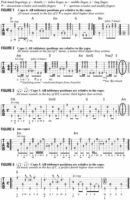
A Tribute to Joan Baez’s Celebrated Fingertyle Guitar Playing
A tribute to folk icon Joan Baez’s celebrated fingertyle guitar playing Joan Baez (b. 1941) began her performing career at age 17, playing traditional folk songs in Boston-area coffee shops while studying dramatic arts in college.
Within a year, word of her soaring soprano and commanding fingerstyle presence led to a Newport Folk Festival appearance and deal with Vanguard Records, which issued the aspiring singer-guitarist’s self-titled debut in 1960. By 1962, Baez had three albums out and was on the cover of Time magazine.
Her country/folk, blues, gospel and ballad interpretations would soon prompt legions of rockers to put their mark on songs she popularized—“Babe, I’m Gonna Leave You” (Led Zeppelin), “John Riley” (the Byrds), “Jackaroe” (Grateful Dead), “House of the Rising Sun” (the Animals) and “Long Black Veil” (the Band).
By decade’s end, Baez—along with Bob Dylan (she was an early Dylan advocate, covering his songs on albums and inviting him onstage at concerts)—became legendary for protest songs (Vietnam), which were key components in the civil/human rights movement.
Today, 30-plus albums later, Baez’ career—as musician, writer and activist—has never waned. Inducted into the Rock and Roll Hall of Fame on April 7 of this year, she is on tour with Mary Chapin Carpenter and the Indigo Girls and still has a lot to say (read on). Let’s tip our hat to Joan’s fine acoustic guitar playing, with an overview of her eclectic fingertyle work.
Baez’s self-titled debut opens with “Silver Dagger,” a traditional ballad that JB transformed into a “double-timed” juggernaut—a speedy mix of thumbed bass notes (Baez often uses a thumbpick) and finger-strummed upper-register chord tones, akin to FIGURE 1. Side Two of the album kicks off with the English folk song “John Riley,” which Baez mutates into a quasi Latin-flavored groove-fest, like FIGURE 2, featuring flamenco-style strums in the first half of each bar.
Use your ring, middle, and index fingers to “explode” outwardly—one at a time—from a closed fist, downwardly raking fingernails across strings. Baez’s fifth album, Joan Baez/5 (1964), features a mix of traditional songs and tunes penned by contemporaries like Bob Dylan, Johnny Cash and Phil Ochs, the latter of whom wrote the leadoff track, “There But for Fortune,” which informs FIGURE 3.
Note the dramatic effect of pedal point—in this case, keeping the tonic (G) in the bass while other chords shift above it (C/G, Cm/G, G). Baez employs Travis picking throughout, alternating between the sixth and fourth strings with the thumb while arpeggiating notes on the top three strings. “Diamonds & Rust” is one of Baez’ most well-known original songs and also has the distinction of having been covered by metal icons Judas Priest (on 1977’s Sin After Sin), ironically providing that band with their first radio hit.
The title track and opener for Baez’s 1975 album, “Diamonds” is propelled by a dramatic arpeggio figure—like a classical guitar etude—similar to FIGURE 4.
We’ll close this lesson with FIGURE 5, a nod to “Nasty Man,” a brand new composition inspired by Baez’ reaction to the current political climate in the U.S., which was accompanied by a video posted online that quickly went viral).
Source: www.guitarworld.com











